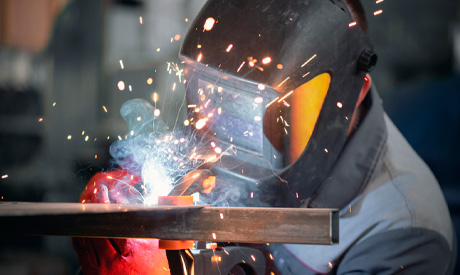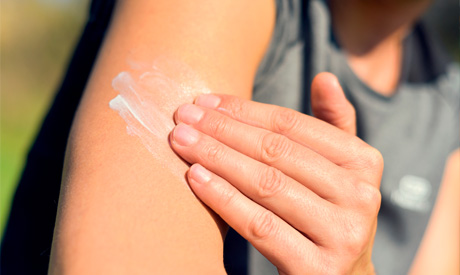Sun Protection for Outdoor Workers
CAREX Canada, a multi-institution team of researchers and specialists with expertise in epidemiology and toxicology, reported approximately 1.7 million Canadians are exposed to the sun and ultraviolet radiation at their place of work. The workforce with the most exposure to the sun in Canada are those in construction, agriculture, and facility care and maintenance1.
Outdoor workers have a three and a half times greater risk of skin cancer in comparison to those who primarily work indoors, and at least 5,000 skin cancer cases each year are attributed to sun exposure at work2.
What is Ultraviolet Radiation (UV)?
Ultraviolet radiation, commonly referred to as UV rays or radiation, is an invisible type of radiation and energy that is emitted by the sun or an artificial source3.
UV radiation is4:
- Classified as a carcinogen — meaning it is cancerous to our bodies
- Not related to temperature and is still present in our environment on sunny or cloudy days
- Invisible wherein it cannot be seen or felt, and can bounce off reflective surfaces like metal, concrete, water, and snow
Type of UV Radiation
UV radiation can be categorized into three types of radiation, based on their wavelengths:
UV-A is a long-range UV radiation that can permeate deep into our skin layer and tissue. This can result in immediate tanning and premature aging of the skin and is a factor in developing certain skin cancers. Approximately 95 percent of UV-A gets through to our earth’s surface since it is not easily absorbed by our ozone layer3.
UV-B has a medium radiation wavelength that can penetrate the outer protective layer of our skin. This can lead to delayed tanning, sunburns and cause most skin cancers. A large amount of this type of radiation gets absorbed by our ozone, allowing approximately 5 percent to reach our planet’s surface3.
UV-C has the shortest radiation wavelength and is considered very dangerous to all forms of life, even with short exposures. Fortunately, UV-C radiation gets filtered out by our ozone layer and can not reach the earth’s surface. However, UV-C can be artificially created to kill bacteria3.
What is Sunburn?
A sunburn, also called erythema, is caused by overexposure to UV radiation. While sunburn symptoms are typically temporary, such as red and inflamed skin that is painful to the touch, skin damage can accumulate throughout your life that can result in developing serious long-term health complications — including skin cancer5.
Is Your Workforce at Risk?

Outdoor Workers
Outdoor workers have a significantly higher risk of developing skin cancer compared to those who work indoors, and having five or more sunburns throughout your life doubles the risk for skin cancer6.
A survey conducted by Sun Safety at Work Canada identified that outdoor workers were not adequately protected from the sun, where less than 50 percent of workers wore sunscreen, long-sleeved shirts, and hard hats with a brim7.

Vehicle Drivers
Individuals sitting in a vehicle can be at risk of significant exposure to harmful UV radiation. Most glass used for windows provides moderate protection against UV-B radiation, but not UV-A rays8. Consequently, this may present a specific risk to public transit-drivers, taxis, and delivery drivers who spend a lot of time behind the wheel.

Welders
According to the Canadian Centre of Occupational Health and Safety, welding arcs give off radiation over a broad range of wavelengths, which can emit strong UV and infrared radiation that can burn and damage unprotected skin, just like UV radiation in sunlight9.
Protect Your Workforce
In an ideal environment, controlling your workforce’s exposure to the sun is a fundamental step in preventing skin damage and cancer. However, for outdoor workers, it may not be plausible to minimize the amount of time they spend outdoors. In such instances, we recommend encouraging the following practices to keep your outdoor workforce as protected as possible.

Protective Clothing
Encourage your workers to stay covered up. Protective clothing is a simple and highly effective method of protection against UV radiation10. Protective clothing could entail long-sleeve shirts, gloves, hard hats with brims that can help protect your scalp and provide shade for your face, neck, and ears, as well as quality eye protection.

Sunscreen
Even if you are wearing protective clothing, it is still necessary to apply sunscreen — especially on areas that are exposed to the sun, such as your face, the back of your neck and arms. It is important to apply the appropriate amount of sunscreen to ensure adequate protection and coverage for your skin, as well as re-apply it for ongoing protection.
For instance, we recommend you apply sunscreen with a minimum sun protection factor (SPF) of 30 at least 15 minutes before sun exposure. You should use approximately two tablespoons of sunscreen and apply it evenly to your arms, legs, body, and face, which includes your neck and ears. You should also aim to re-apply the sunscreen every two hours or even earlier depending on the level of physical exertion or perspiration10.

Seek Shade
Although you should never rely on shade alone, shade can provide a good barrier against UV radiation. We would recommend workers to take breaks or work in shaded areas whenever possible, particularly during peak UV hours that typically occur between 11 am to 3 pm. Your outdoor workforce should still wear the appropriate protective clothing and use sunscreen for optimal protection10.
Sources:
1 https://www.carexcanada.ca/profile/uv_radiation_solar/#:~:text=Occupational%20Exposures%20Overview,for%20exposure%20to%20solar%20radiation
2 https://dermatology.ca/public-patients/sun-protection/outdoor-worker-sun-safety-information/
3 https://www.canada.ca/en/health-canada/services/health-risks-safety/radiation/types-sources/ultraviolet.html
4 https://www.skcin.org/skinCancerInformation/solarUVRadiation.htm
5 https://www.canada.ca/en/health-canada/services/sun-safety/first-aid-advice-sunburn-heat-illness.html
6 https://www.ncbi.nlm.nih.gov/pmc/articles/PMC6130134/#:~:text=The%20main%20findings%20were%20
7 https://www.cancercareontario.ca/en/cancer-facts/outdoor-workers-not-adequately-protected-sun
8 https://www.skincancer.org/blog/surprising-danger-planes-trains-automobiles/
9 https://www.ccohs.ca/oshanswers/safety_haz/welding/eyes.html#:~:text=UV%20radiation%
10 https://www.skcin.org/downloads/SkcinBooklet2022.pdf





